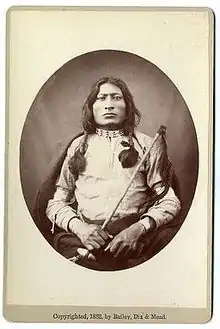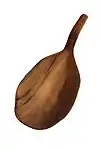One Bull | |
|---|---|
Tȟatȟáŋka Waŋžíla | |
 One Bull in 1882 | |
| Born | c. 1853 |
| Died | 1947 (aged 93–94) |
| Nationality | Lakota |
| Other names | Lone Bull, Henry Oscar One Bull |

One Bull, sometimes given as Lone Bull[1] (Lakota: Tȟatȟáŋka Waŋžíla;[2] c. 1853–1947), later known as Henry Oscar One Bull, was a Lakota Sioux man best known for being the nephew and adopted son of Sitting Bull.[3][4] He fought at Battle of the Little Bighorn and, in his later years, provided interviews about his life as a warrior.
Early life
His mother was Sitting Bull's sister Good Feather;[5] his father was Makes Room[6] and his brother was White Bull.[7][8]: 63
One Bull was adopted by Sitting Bull in 1857 at the age of four.[8]: 26 One Bull recalled that Sitting Bull gave him a pinto pony when he was about six years old; One Bull named the pony Itanchan, or Chief.[6] He treated the horse well, never whipping or otherwise abusing the pony, which became the "swiftest runner in the camp, the envy of all and the object of many rejected offers of purchase".[6]
Life as a warrior
One Bull was a Heyoka, one who had dreamed of thunderbirds.[6]
One Bull participated in Battle of the Little Bighorn in 1876. He arrived with his horse and Sitting Bull's. He rode his mother to safety and then joined the fight. Sitting Bull told him, "Fear nothing. Go straight in". One Bull recounted having killed several fleeing troopers in the battle.[8]: 94, 96 He wore his uncle's shield during the Battle of Little Bighorn. One Bull joined his uncle in fleeing to Canada following the Battle of the Little Bighorn in 1876.
In subsequent years, he was highly regarded amongst the Plains Indians for his rescuing of a warrior named Good Bear Boy.[9]
Sitting Bull's band remained in the "Grandmother's Country" until he surrendered in North Dakota in 1881. One Bull stood by Sitting Bull at his surrender.[10] He later contradicted the narrative that Sitting Bull had said at his surrender: "Let it be recorded that I was the last man of my people to lay down my gun." One Bull reported that Sitting Bull was silent.[8]: 172
One Bull, who had been away hauling freight north of Fort Yates, had returned the night before the massacre of Sitting Bull. His wife, Red Whirlwind, who was pregnant, had been sleeping in Sitting Bull's cabin. When One Bull heard the shots, he rushed to the cabin and got his wife to safety, who had escaped the gunfire, only returning to Sitting Bull's home after the troops had gone.[8]: 269, 279
Later life
Following the death of Sitting Bull, One Bull reported that all of his personal household goods and some of his horses were taken.[8]: 304–305
One Bull is listed as living in 1929 at the Standing Rock Agency,[11] where he was prominent in tribal matters.[8]: 319
One Bull participated in interviews about his experiences with Sitting Bull, as did his brother White Bull, a famous Lakota warrior and chief contributor to Stanley Vestal's biography of their uncle.[7]
Depiction in media
One Bull was portrayed by Nathan Lee Chasing His Horse in the television miniseries Bury My Heart at Wounded Knee (2007).[12][13]
References
- ↑ Vestal, Stanley (2014-12-17). Sitting Bull: Champion of the Sioux. University of Oklahoma Press. ISBN 978-0-8061-7799-1.
- ↑ New Lakota Dictionary, 2008
- ↑ "Sioux to Elect Chief in Spring". Reading Eagle. Reading, Pennsylvania. 16 January 1910. p. 8.
- ↑ Miller, David Humphreys (June 1971). "Echoes of The Little Bighorn". American Heritage. 22 (4). Retrieved 1 October 2020.
- ↑ LaPointe, Ernie (2009-09-01). Sitting Bull: His Life and Legacy. Gibbs Smith. ISBN 978-1-4236-1266-7.
- 1 2 3 4 Utley, Robert M. (1993). The lance and the shield : the life and times of Sitting Bull (1st ed.). New York: Henry Holt. ISBN 0-8050-1274-5. OCLC 27106879.
- 1 2 Thackeray, Lorna (24 June 2006). "Markers honor fallen warriors". Billings Gazette. Billings, Montana: Casper Star-Tribune.
- 1 2 3 4 5 6 7 Yenne, Bill (2008). Sitting Bull. Yardley, Pa.: Westholme Pub. ISBN 978-1-59416-060-8. OCLC 184822192.
- ↑ Hardorff, Richard G. (1999-01-01). Hokahey! A Good Day to Die!: The Indian Casualties of the Custer Fight. U of Nebraska Press. ISBN 978-0-8032-7322-1.
- ↑ Sprague, Donovin Arleigh (2004). Standing Rock Sioux. Arcadia Publishing. ISBN 978-0-7385-3242-4.
- ↑ "Little Big Horn Warriors" (PDF). Friends of Little Big Horn. Retrieved 1 October 2020.
- ↑ "'Bury My Heart at Wounded Knee' leads Emmy nominees with 17". Rapid City Journal Media Group. Retrieved 2020-09-30.
- ↑ Marill, Alvin H. (2010-10-11). Movies Made for Television: 2005-2009. Scarecrow Press. ISBN 978-0-8108-7659-0.